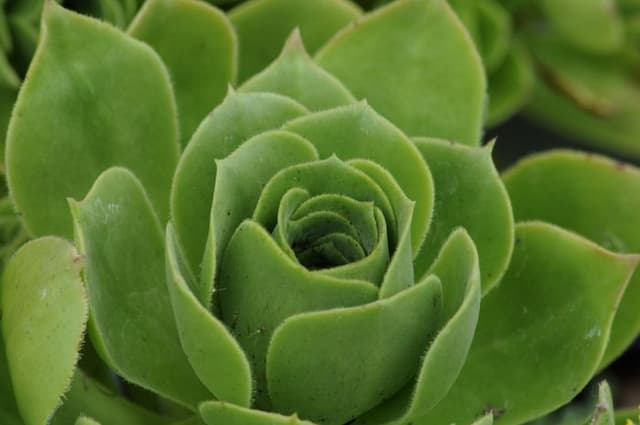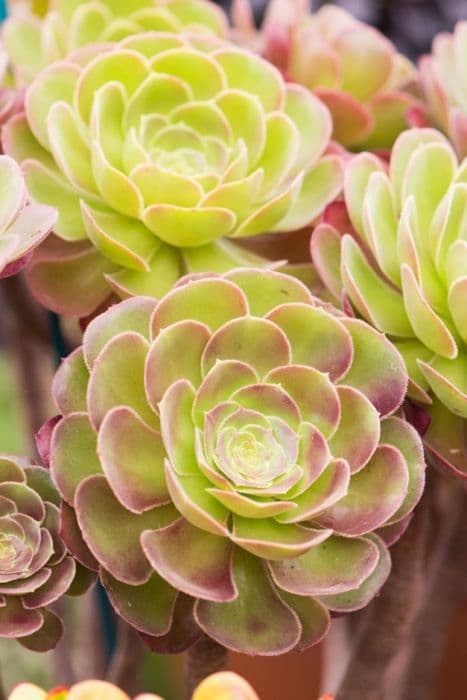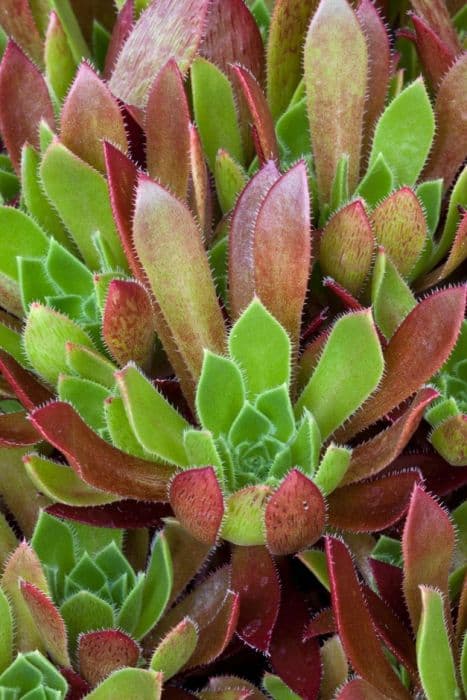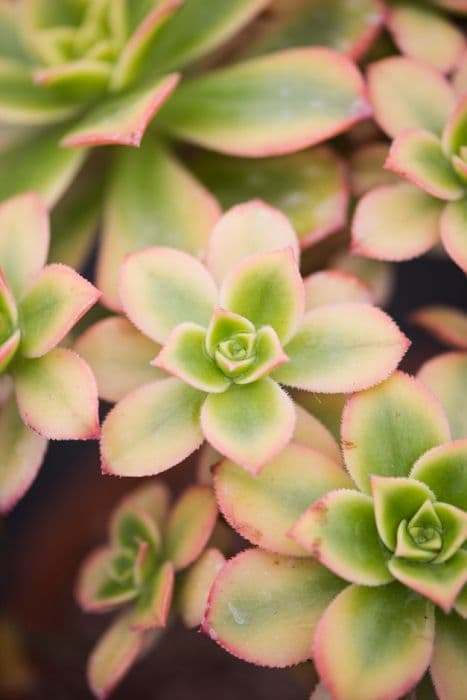Giant Velvet Rose Aeonium hierrense

ABOUT
Aeonium hierrense, known as the Giant Houseleek, displays a distinctive rosette pattern that is typical of the Aeonium genus. It bears fleshy, spoon-shaped leaves which are glossy and often have a waxy coating, enhancing their succulence. These leaves can exhibit shades of green, often with a hint of blue or purple, and occasionally feature a reddish tint around the margins, particularly when exposed to sunny conditions. The leaves are arranged in a symmetrical pattern, emerging from a central point, and can vary in color intensity depending on the amount of sunlight the plant receives. As the plant ages, the lower leaves may wither and drop, enabling the plant to direct its energy towards new growth. The Giant Houseleek usually has a branched, tree-like stem that supports the weight of the rosettes and gives the plant its architectural appeal. This succulent can also produce large conical clusters of small, starry flowers on tall stems that rise above the foliage, though it blooms infrequently. These flowers can be yellow or pale green, adding a dash of color to its striking foliage. Overall, the aesthetic of Aeonium hierrense is that of a sculptural, highly ornate plant that stands out for its rosette-forming habit and robust appearance.
About this plant
 Names
NamesFamily
Crassulaceae
Synonyms
Giant Velvet Rose, Hierro Giant Houseleek
Common names
Aeonium hierrense, Sempervivum hierrense, Greenovia aurea subsp. hierrensis.
 Toxicity
ToxicityTo humans
The plant known as Aeonium hierrense, commonly referred to as Giant Houseleek, is not widely recognized for being toxic to humans. There is limited information regarding its toxicity, and it is not typically considered a poisonous plant. Consequently, there are no well-documented symptoms of poisoning from ingesting Aeonium hierrense. However, as a general precaution, it is advisable not to ingest parts of ornamental plants due to potential individual sensitivities or the risk of gastrointestinal discomfort.
To pets
The Aeonium hierrense, commonly known as Giant Houseleek, is not well-known for being toxic to pets either. It tends to be safe for pets, and there is a lack of documented cases of poisoning in animals from consuming this plant. Thus, specific symptoms of poisoning are not well established. Nonetheless, pet owners should still be cautious and prevent pets from eating decorative plants to avoid possible stomach upset or individual allergic reactions.
 Characteristics
CharacteristicsLife cycle
Perennials
Foliage type
Evergreen
Color of leaves
Green
Flower color
Yellow
Height
2 feet (60 cm)
Spread
2 feet (60 cm)
Plant type
Succulent
Hardiness zones
10
Native area
Canary Islands
Benefits
 General Benefits
General Benefits- Ornamental Appeal: Aeonium hierrense, commonly known as the "Giant Houseleek," adds aesthetic value to gardens with its rosettes of fleshy, spoon-shaped leaves that can provide a striking visual interest.
- Drought Tolerance: It is highly drought resistant, which makes it suitable for xeriscaping and a great choice for water-wise gardens.
- Low Maintenance: This succulent requires minimal care, making it an ideal plant for busy gardeners or those new to plant care.
- Easy Propagation: It can be easily propagated from cuttings, which allows gardeners to increase their collection without additional cost.
- Suitable for Containers: It grows well in pots, making it a versatile choice for patios, balconies, and indoor settings.
- Attracts Pollinators: When in bloom, the plant's flowers can attract pollinators such as bees and butterflies, benefiting the local ecosystem.
- Long Lifespan: As a perennial plant, it has a long lifespan that can provide enjoyment for many years.
- Seasonal Interest: Its foliage provides year-round interest, while its blooms add a seasonal highlight to the garden.
 Medical Properties
Medical Properties- This plant is not used for medical purposes.
 Air-purifying Qualities
Air-purifying QualitiesThis plant is not specifically known for air purifying qualities.
 Other Uses
Other Uses- Aeonium hierrense, commonly known as the "Giant Houseleek," can be used in miniature gardens or fairy gardens due to its unique and ornamental appearance, adding a touch of whimsy and enchantment to small-scale landscapes.
- The rosettes of the Giant Houseleek can serve as natural artwork when arranged in intricate patterns in ornamental garden beds, creating living sculptures that change and grow with time.
- Its drought-resistant nature makes Aeonium hierrense ideal for xeriscaping, a landscaping method that reduces or eliminates the need for supplemental water from irrigation, promoting water conservation.
- Aeonium hierrense can be cultivated in rooftop gardens where other plants might struggle, as it can endure windy and sunny conditions while providing greenery in urban environments.
- The thick and fleshy leaves of the Giant Houseleek have been traditionally used in some cultures for temporary roof repairs; their moisture retention properties can offer short-term protection against minor leaks.
- Because of their interesting look, the rosettes of Aeonium hierrense are sometimes used in floral arrangements and bouquets, particularly in succulent-themed weddings or events for a unique aesthetic.
- In educational settings, the Giant Houseleek serves as a living example to teach about succulent plant adaptations, CAM photosynthesis, and water conservation strategies in plants.
- This plant's ability to root from cuttings easily makes it an excellent choice for starting community gardens or gardening programs focused on sustainability and plant propagation education.
- The contrasting colors and shapes of Aeonium hierrense can be used to create texture and visual depth in rock gardens, complementing other alpine and desert plants.
- As an interactive garden element, the fleshy leaves of the Giant Houseleek can be used to demonstrate principles of water storage and retention to children, fostering an interest in botany and plant biology.
Interesting Facts
 Feng Shui
Feng ShuiThe Aeonium hierrense, more commonly known as the "Tree Houseleek," is not used in Feng Shui practice.
 Zodiac Sign Compitability
Zodiac Sign CompitabilityThe Tree Houseleek is not used in astrology practice.
 Plant Symbolism
Plant Symbolism- Resilience: Aeonium hierrense, commonly known as "Tree Houseleek," is known for its ability to survive in arid conditions and poor soils, symbolizing the ability to endure and thrive in challenging situations.
- Adaptation: The Tree Houseleek represents the ability to adapt to one's environment, as the plant's succulent characteristics enable it to retain water and adapt to its surroundings.
- Conservation: As a water-retentive plant, it signifies the importance of conserving resources and using them efficiently.
- Timelessness: With its perennial nature and longevity, the Tree Houseleek embodies timelessness and permanence in the plant kingdom.
- Beauty: The rosettes and symmetry of Aeonium hierrense are aesthetically pleasing, symbolizing natural beauty and the appeal of nature's patterns.
 Water
WaterThe Aeonium hierrense, commonly known as Giant Aeonium, should be watered deeply but infrequently, allowing the soil to completely dry out between waterings. In general, watering once every 7 to 10 days during the active growth season in spring and summer is sufficient. During the winter dormancy period, reduce watering to once a month. Each watering session should provide enough water to soak the soil thoroughly, which can be approximately 16 ounces for smaller pots or up to 1-2 gallons for larger containers, depending on the size of the plant and pot.
 Light
LightGiant Aeonium prefers a spot with bright, indirect sunlight or partial shade. It can tolerate full sun in cooler coastal areas but in hotter climates, it should be protected from the harsh afternoon sun which can scorch its leaves. A location that receives morning sunlight and afternoon shade would be ideal for this succulent.
 Temperature
TemperatureThe Giant Aeonium thrives best in temperatures between 40 to 100 degrees Fahrenheit; however, it can survive brief periods outside this range. The ideal temperature conditions are mild, ranging from 65 to 75 degrees Fahrenheit. It is not frost hardy, so if the temperature is expected to drop below 40 degrees Fahrenheit, it is crucial to protect the plant or bring it indoors.
 Pruning
PruningPruning the Giant Aeonium is necessary to remove any dead or damaged leaves and to maintain its attractive appearance. It is best pruned in the spring or early summer, which is the beginning of its active growth period. Pruning can be performed annually or as needed when you notice parts that require removal. Always use clean, sharp scissors or pruning shears to make precise cuts.
 Cleaning
CleaningAs needed
 Soil
SoilThe Giant Houseleek thrives best in a well-draining soil mix that is composed of equal parts coarse sand, perlite, and regular potting soil. Aim for a slightly acidic to neutral pH range between 6.0 to 7.5 for optimal growth.
 Repotting
RepottingThe Giant Houseleek should be repotted once every two to three years to provide it with fresh soil and to accommodate its growing size. Ensure to use a well-draining soil mixture during repotting.
 Humidity & Misting
Humidity & MistingThe Giant Houseleek prefers moderate humidity levels, however, it is quite adaptable and can tolerate lower humidity environments typical of most homes as long as it's not too dry.
 Suitable locations
Suitable locationsIndoor
Place Giant Houseleek in bright indirect light indoors.
Outdoor
Grow Giant Houseleek in sunny spots, shelter from heavy rain.
Hardiness zone
9-11 USDA
 Life cycle
Life cycleThe life of Aeonium hierrense, commonly known as Giant Velvet Rose or Hierro Giant Houseleek, begins with seed germination, which requires well-draining soil and appropriate moisture levels. Upon sprouting, the seedling emerges and develops into a rosette with fleshy, spoon-shaped leaves. As a perennial, the plant enters a juvenile phase, growing larger each year, with some rosettes spanning up to 60 centimeters in diameter. It achieves maturity within a few years, at which point it may produce a tall, conical flower spike bearing clusters of small, star-shaped flowers, typically yellow in color. After flowering, which occurs once in the plant's lifetime, the individual rosette that has bloomed will die, but the plant can continue to live and propagate through offsets. Over the years, the plant maintains a cycle of producing new rosettes, flowering, and dying, with propagation ensuring its continuation.
 Propogation
PropogationPropogation time
Spring-Early Summer
The Aeonium hierrense, commonly known as the Giant Houseleek, can be propagated effectively through the use of stem cuttings. This method is popular due to its simplicity and high success rate. To propagate, a healthy stem cutting of about 2 to 4 inches (5 to 10 cm) is selected and cleanly cut from the parent plant, ideally during the growth season in spring or early summer. The cutting should then be allowed to dry and callous over for several days to prevent rotting when planted. Once calloused, the cutting is placed in well-draining soil and given minimal water until roots develop, after which it can be watered regularly. This method leverages the plant's natural ability to form roots from cut tissue and typically results in a new, independent plant within a few weeks to a few months.









